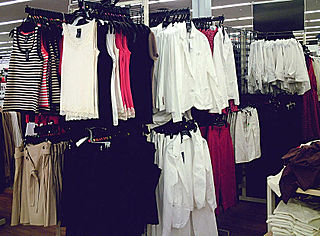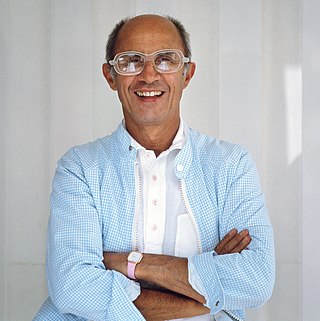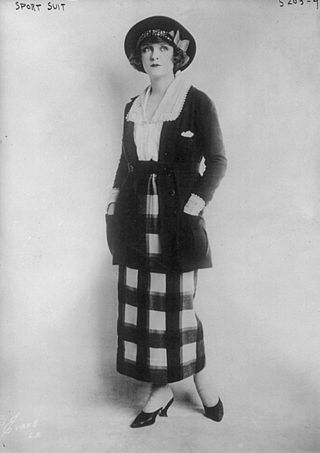Related Research Articles

Karl Otto Lagerfeld was a German fashion designer, photographer, and creative director.

A miniskirt is a skirt with its hemline well above the knees, generally at mid-thigh level, normally no longer than 10 cm (4 in) below the buttocks; and a dress with such a hemline is called a minidress or a miniskirt dress. A micro-miniskirt or microskirt is a miniskirt with its hemline at the upper thigh, at or just below crotch or underwear level.

Ready-to-wear (RTW) – also called prêt-à-porter, or off-the-rack or off-the-peg in casual use – is the term for garments sold in finished condition in standardized sizes, as distinct from made-to-measure or bespoke clothing tailored to a particular person's frame. In other words, it is a piece of clothing that was mass produced in different sizes and sold that way instead of it being designed and sewn for one person. The term off-the-peg is sometimes used for items other than clothing, such as handbags. It is the opposite of haute couture.

Count Hubert James Marcel Taffin de Givenchy was a French aristocrat and fashion designer who founded the luxury fashion and perfume house of Givenchy in 1952. He is famous for having designed much of the personal and professional wardrobe of Audrey Hepburn and clothing for Jacqueline Bouvier Kennedy. He was named to the International Best Dressed List Hall of Fame in 1970.

Sir Norman Bishop Hartnell was a leading British fashion designer, best known for his work for the ladies of the royal family. Hartnell gained the Royal Warrant as Dressmaker to Queen Elizabeth in 1940, and Royal Warrant as Dressmaker to Queen Elizabeth II in 1957. Princess Beatrice also wore a dress designed for Queen Elizabeth II by Hartnell for her wedding in 2020.

André Courrèges was a French fashion designer. He was particularly known for his streamlined 1960s designs influenced by modernism and futurism, exploiting modern technology and new fabrics. Courrèges defined the go-go boot and along with Mary Quant, is one of the designers credited with inventing the miniskirt.

Christian Marie Marc Lacroix is a French fashion designer. The name may also refer to the company he founded.

Valentino Clemente Ludovico Garavani, known mononymously as Valentino, is an Italian fashion designer, the founder of the Valentino brand and company. His main lines include Valentino, Valentino Garavani, Valentino Roma, and R.E.D. Valentino.

A hobble skirt was a skirt with a narrow enough hem to significantly impede the wearer's stride. It was called a "hobble skirt" because it seemed to hobble any woman as she walked. Hobble skirts were a short-lived fashion trend that peaked between 1908 and 1914.

Christian Dior SE, commonly known as Dior, is a French multinational luxury fashion house that is controlled and chaired by French businessman Bernard Arnault, who also heads LVMH. Dior holds 42.36% of the shares and 59.01% of the voting rights within LVMH.

Emanuel Ungaro was a French fashion designer who founded the fashion house called the House of Emanuel Ungaro in 1965.

Azzedine Alaïa was a Tunisian couturier and shoe designer, particularly successful beginning in the 1980s.

Fashion of the 1960s featured a number of diverse trends, as part of a decade that broke many fashion traditions, adopted new cultures, and launched a new age of social movements. Around the middle of the decade, fashions arising from small pockets of young people in a few urban centers received large amounts of media publicity, and began to heavily influence both the haute couture of elite designers and the mass-market manufacturers. Examples include the mini skirt, culottes, go-go boots, and more experimental fashions, less often seen on the street, such as curved PVC dresses and other PVC clothes.

Fashion in the 1970s was about individuality. In the early 1970s, Vogue proclaimed "There are no rules in the fashion game now" due to overproduction flooding the market with cheap synthetic clothing. Common items included mini skirts, bell-bottoms popularized by hippies, vintage clothing from the 1950s and earlier, and the androgynous glam rock and disco styles that introduced platform shoes, bright colors, glitter, and satin.

The most characteristic North American fashion trend from the 1930s to 1945 was attention at the shoulder, with butterfly sleeves and banjo sleeves, and exaggerated shoulder pads for both men and women by the 1940s. The period also saw the first widespread use of man-made fibers, especially rayon for dresses and viscose for linings and lingerie, and synthetic nylon stockings. The zipper became widely used. These essentially U.S. developments were echoed, in varying degrees, in Britain and Europe. Suntans became fashionable in the early 1930s, along with travel to the resorts along the Mediterranean, in the Bahamas, and on the east coast of Florida where one can acquire a tan, leading to new categories of clothes: white dinner jackets for men and beach pajamas, halter tops, and bare midriffs for women.

History of fashion design refers specifically to the development of the purpose and intention behind garments, shoes, accessories, and their design and construction. The modern industry, based around firms or fashion houses run by individual designers, started in the 19th century with Charles Frederick Worth who, beginning in 1858, was the first designer to have his label sewn into the garments he created.

Sportswear is an American fashion term originally used to describe separates, but which since the 1930s has come to be applied to day and evening fashions of varying degrees of formality that demonstrate a specific relaxed approach to their design, while remaining appropriate for a wide range of social occasions. The term is not necessarily synonymous with activewear, clothing designed specifically for participants in sporting pursuits. Although sports clothing was available from European haute couture houses and "sporty" garments were increasingly worn as everyday or informal wear, the early American sportswear designers were associated with ready-to-wear manufacturers. While most fashions in America in the early 20th century were directly copied from, or influenced heavily by Paris, American sportswear became a home-grown exception to this rule, and could be described as the American Look. Sportswear was designed to be easy to look after, with accessible fastenings that enabled a modern emancipated woman to dress herself without a maid's assistance.

Anne Fogarty was an American fashion designer, active 1940–1980, who was noted for her understated, ladylike designs that were accessible to American women on a limited income. She started out as a model in New York in 1939, working for Harvey Berin on Seventh Avenue, before studying fashion design. She eventually secured a full-time design job in 1948, and became well-known for full-skirted designs with fitted bodices, inspired by Dior's New Look.
Clive Evans, better known as Clive, was a London-born fashion designer of the 1960s who attracted a number of celebrity fans and was promoted internationally as a high fashion designer from Swinging London.
Lachasse was a British couture firm operating from 1928 until 2006, making it one of the longest surviving high fashion houses in London.
References
- 1 2 3 Lambert, Eleanor (1976). World of Fashion: People, Places, Resources . R. R. Bowker Company. p. 95. ISBN 9780835206273.
- 1 2 3 Varro, Barbara (5 March 1973). "Cool man Luke designs for the ultrasophisticated". Chicago Sun-Times.
- 1 2 Lester, Richard (2013). Dress of the year. Antique Collectors' Club. pp. 74–75. ISBN 9781851497256.